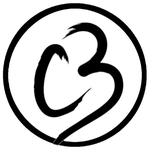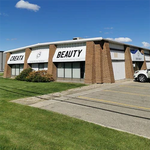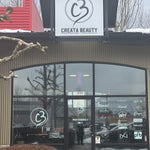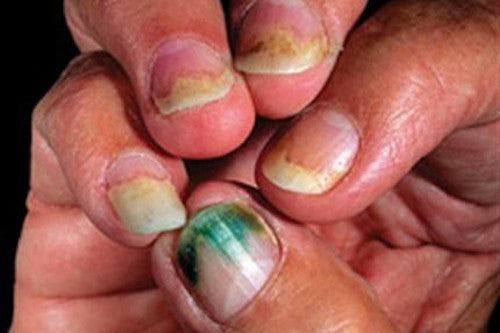 For years we have been taught that green nails = MOLD! However, experts are now telling us that this is not the case. What nail techs would normally consider a mold or fungal infection is actually a medical disorder caused by a bacteria called “Pseudomonas.” Pseudomonas is defined as: a common household bacteria that thrives in many environments, including water and moist soil.
For years we have been taught that green nails = MOLD! However, experts are now telling us that this is not the case. What nail techs would normally consider a mold or fungal infection is actually a medical disorder caused by a bacteria called “Pseudomonas.” Pseudomonas is defined as: a common household bacteria that thrives in many environments, including water and moist soil.
Mold is a fungus, but green spots are bacterial. Pseudomonas bacteria can be found almost anywhere-from plants and animals to soil, and even in water. Because these bacteria are so common, people can develop green nails even without having artificial nail enhancements. It can be caused simply by the skin underneath the nail being exposed to the bacterium.
Because green nails can develop so easily even without enhancements, nail techs must be extremely cautious about thoroughly following proper cleaning, sanitization, and disinfection procedures. Shortcuts can result in infection. This applies to their implements, all salon surfaces, their own hands, and the nails and hands of the clients they are working on. Techs must be immaculate in the cleaning and disinfection of the nail surface before applying any product. Otherwise, you could be trapping bacteria between the product and the natural nail.
Even after careful prep and disinfection of the nail client can still be exposed to these bacteria. It could be something as simple as the client touching her nails to her face and the tech not re-cleansing the nail plate before application of product. When product is applied over a nail that has the pseudomonas bacteria, it creates an almost oxygen free environment that these bacteria will thrive in. The bacteria eat the oils and excrete a dark substance which is what we see when the nail turns green. It is important to note however, that green spots are not caused by moisture like we have been taught in the past. In the case of these bacteria causing green spots between the natural nail and the enhancements there are two main causes: 1) the bacteria was already on the nail plate before the product was applied, likely due to improperly cleaned implements, or poor preparation of nail plate. 2) the adhesion of the product was unsatisfactory and when this happens the bacteria can make their way under the product through a chip, a crack, or a lift.
For techs, treatment for green nails used to be as simple as just filing off the old product, treating with an antiseptic and reapplying product right over the stain that was left behind. However, if the nail is infected, it is no longer in the hands of the nail technician. Pseudomonas is not something nail techs are allowed to treat. These clients must be referred to a physician for proper treatment.
Prevention is the most effective way to deal with pseudomonas. Always follow all sanitary procedures and avoid taking shortcuts in these areas. Also, by educating your clients about nail care they can assist you with the prevention of infection. Instruct your clients not to pick, pry, or glue her nails. When a client glues a lifted or cracked nail the risk of trapping bacteria is largely increased. Advise them of green spots and trapping bacteria on the first visit rather than after they have already glued a cracked or broken nail down.
If you would like more information or have any other questions please feel free to contact us at orders@creatabeauty.com




